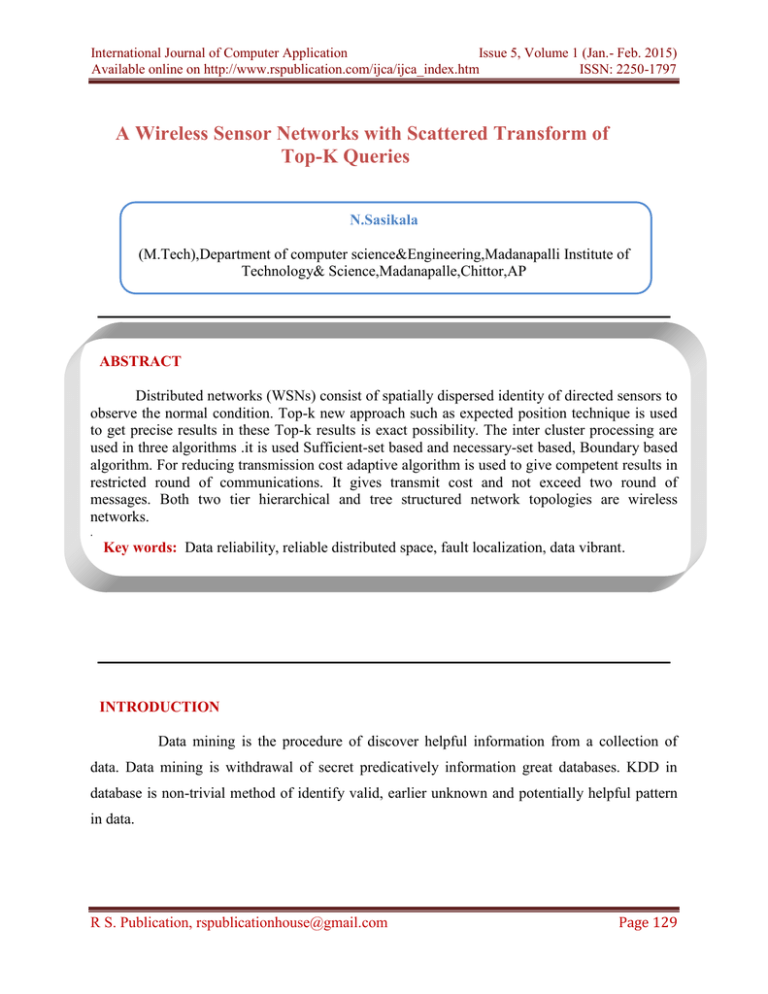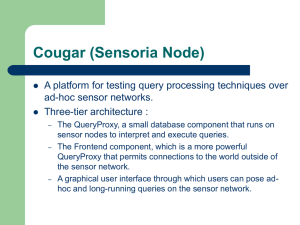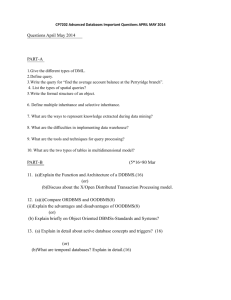International Journal of Computer Application Issue 5, Volume 1
advertisement

International Journal of Computer Application Issue 5, Volume 1 (Jan.- Feb. 2015) Available online on http://www.rspublication.com/ijca/ijca_index.htm ISSN: 2250-1797 A Wireless Sensor Networks with Scattered Transform of Top-K Queries N.Sasikala (M.Tech),Department of computer science&Engineering,Madanapalli Institute of Technology& Science,Madanapalle,Chittor,AP ABSTRACT Distributed networks (WSNs) consist of spatially dispersed identity of directed sensors to observe the normal condition. Top-k new approach such as expected position technique is used to get precise results in these Top-k results is exact possibility. The inter cluster processing are used in three algorithms .it is used Sufficient-set based and necessary-set based, Boundary based algorithm. For reducing transmission cost adaptive algorithm is used to give competent results in restricted round of communications. It gives transmit cost and not exceed two round of messages. Both two tier hierarchical and tree structured network topologies are wireless networks. . Key words: Data reliability, reliable distributed space, fault localization, data vibrant. INTRODUCTION Data mining is the procedure of discover helpful information from a collection of data. Data mining is withdrawal of secret predicatively information great databases. KDD in database is non-trivial method of identify valid, earlier unknown and potentially helpful pattern in data. R S. Publication, rspublicationhouse@gmail.com Page 129 International Journal of Computer Application Issue 5, Volume 1 (Jan.- Feb. 2015) Available online on http://www.rspublication.com/ijca/ijca_index.htm ISSN: 2250-1797 The process of data mining is that mining of data or pattern from data in large database. This process is known as knowledge discovery process. Data mining plays an essential role in the KDD. Knowledge discovery (KDD) process: The following figures show in development of knowledge discovery (KDD). Fig.1 Knowledge Discovery (KDD) process Knowledge discovery (KDD) is the step by step process for extracting knowledge from large databases. Steps in KDD Process: The following are the steps in Knowledge discovery (KDD) process. 1) Data Cleaning 2) Selection 3) Mining 4) Reduction 5) Transformation 6) Pattern evaluation Data Cleaning is the process of detecting and correcting data records from the database. Data Selection is the process selection of the data from the database for mining. R S. Publication, rspublicationhouse@gmail.com Page 130 International Journal of Computer Application Issue 5, Volume 1 (Jan.- Feb. 2015) Available online on http://www.rspublication.com/ijca/ijca_index.htm ISSN: 2250-1797 Data Mining is process that selected data is to mine from the database. Data reduction and transformation Find positive features, invariant representation and dimensionality/variable reduction. In Data transformation the process is choosing functions of data mining as classification, summarization, regression, association and clustering. Pattern evaluation is last step in KDD process, in this process Patterns and knowledge to be used or stored into knowledge-base Architecture of a Data Mining System Fig 2: Data mining Architecture Data mining system can separately mine out all of the expensive knowledge from a known large database, without person intervention REVIEW OF RELATED RESEARCH A.) A cross pruning framework for top-k data collection in wireless sensor networks Wireless sensor networks main problem is due to maintain of energy. In this work, we can explore the methods of in-network collection for answering the queries A top-k request recovers the k data items with the maximum results estimated by a recording role on concerned features of antenna evaluations. Our study shows that existing techniques for handling top-k request, e.g., Tiny Aggregation Service (TAG), are not energy effective due to deficits in their direction-finding organizations and statistics accretion mechanisms. To address these deficits, we propose to develop a new cross pruning (XP) aggregation framework for top-k data collection in wireless sensor networks. The XP framework incorporates several novel ideas to facilitate R S. Publication, rspublicationhouse@gmail.com Page 131 International Journal of Computer Application Issue 5, Volume 1 (Jan.- Feb. 2015) Available online on http://www.rspublication.com/ijca/ijca_index.htm ISSN: 2250-1797 efficient in-network aggregation and filtering, including 1) structure a cluster-tree routing arrangement to aggregate more itemsclosey. 2) implementing a broadcast-then-filter methodology for professionally defeating terminated information communications; and 3) providing a cross pruning procedure to enhance in-network filtering effectiveness. An extensive set of experiments based on simulation has been conducted to evaluate the performance of TAG and the proposed XP framework. The experimental results validate our proposals and show that XP significantly outperforms TAG in energy charge. B.) Ranking with uncertain scores Great data banks with provisional data are suitable in various present procedures contain data combination, position tracking, and network search. In this presentation, we will handle recent situation with uncertain items that are various from traditional classification. Specially, improbability in documentations slash brings a limited instruction concluded proceedings, as opposed to the entire instruction that is expected in the conventional dynamic surroundings. In this work, we existent a new probabilistic design, based on limited orders, to summarize the universe of probable positions initiates from score improbability. In this design we can develop various ranking request kinds with various rules. We designate and evaluate a position of proficient query estimation algorithms. We prove that our techniques can be used to solve the problem of level aggregation in limited instructions. In calculation, we propose original case techniques to divide near query answer. Our unsure estimate uses both actual and artificial information. The provisional training validates the efficacy and usefulness of our skills in unrelated settings. EXISTING SYSTEM Two schemes, additional evidence and crosscheck, were proposed in as solutions for securing top-k query in tiered sensor networks. While the former generates hashes for each consecutive pair of sensed data for verification purpose, the latter performs network-wide broadcast such that the information about the readings is distributed over the entire network and therefore the query result cannot be manipulated. In particular, the idea behind additional evidence is that if each consecutive pair of sensed data is associated with a hash, once an unqualified sensor reading is used to replace the genuine query result, the authority may know because it can find that there are some missing sensor readings for hash verification. On the other hand, the idea behind crosscheck is that the genuine top-k results are distributed to several sensor nodes. With certain R S. Publication, rspublicationhouse@gmail.com Page 132 International Journal of Computer Application Issue 5, Volume 1 (Jan.- Feb. 2015) Available online on http://www.rspublication.com/ijca/ijca_index.htm ISSN: 2250-1797 probability, the authority will find query result incompleteness by checking the other sensor nodes’ sensor readings. Hybrid method is a combined use of additional evidence and crosscheck, attempting to balance the communication cost and the query result incompleteness detection capability. DISADVANTAGES OF EXISTING SYSTEM 1. There is no trusted central authority like proxy node in for such responsibility. 2. In real world deployment, these requirements are difficult to meet. 3. The methods do not handle the data privacy issue. PROPOSED SYSTEM The Verifiable top-k Query (VQ) schemes based on the novel dummy reading-based anonymization framework are proposed for privacy preserving top-k query result integrity verification in tiered sensor networks. A randomized and distributed version of Order Preserving Encryption, rdOPE, is proposed to be the privacy foundation of our methods.AD-VQ-static achieves the lower communication complexity at the cost of slight detection capability degradation, which could be of both theoretical and practical interests. Analytical studies, numerical simulations, and prototype implementation are conducted to demonstrate the practicality of our proposed methods. A cell is a connected multihop network composed of a storage node and a number of ordinary sensors. Storage nodes are storage-abundant, can communicate with the authority via direct or multi-hop communications, and are assumed to know their affiliated cells. Time on the nodes has been synchronized and is divided into epochs. Note that time synchronization among nodes can be achieved by using algorithms. ADVANTAGES OF PROPOSED SYSTEM 1. The message m to be communicated is associated with HMACK; the use of HMAC naturally guarantees the data authenticity and integrity. 2. Hybrid Crosscheck incurs tremendous communication cost because it involves the data broadcast over the cell. 3. SMQ achieves the data confidentiality through the use of bucket index R S. Publication, rspublicationhouse@gmail.com Page 133 International Journal of Computer Application Issue 5, Volume 1 (Jan.- Feb. 2015) Available online on http://www.rspublication.com/ijca/ijca_index.htm ISSN: 2250-1797 4. IMPLEMENTATION PT TOPK QUERY PROCESSING: PTTOP K-queries provide with good conditions for the plagued discrete exclusion problem. Query answer container exist attain by inquiring the tuples in sliding level organize starting the sorted table it is still denoted plainness of a T. it can simply close to the top rank Ktuples completely in the react set as extended since their confidence are more to p as their experience as PT-TOP K answer are not reliant on the subsistence of more than a few further tuples. SENSOR NETWORKS: The partial energy resources accessible at sensors nodes, the main issues are enhanced energy efficient technique to decrease infrastructure and force expenses in the network. Estimated it base data aggregation technique .We can planned. The main scheme is to trade-off some data feature for enhance force competence. That it base on numerical model technique a form motivated advance be planned to balanced the assurance of faults respond adjacent to the report charge in the networks. R S. Publication, rspublicationhouse@gmail.com Page 134 International Journal of Computer Application Issue 5, Volume 1 (Jan.- Feb. 2015) Available online on http://www.rspublication.com/ijca/ijca_index.htm ISSN: 2250-1797 DATA PRUNING: The Cluster head are reliable for produce insecure tuples of a data from the gather unprocessed sensors reading inside their cluster. it react a uncertainty, it is normal for the clusters head in the direction of cut down lay off undecided tuples of a data facing release to the position. It organizes to decrease statement and force charge. The input substance here is to obtain a compressed set of tuple necessary for the answer to the base station to the probabilistic TOP K- queries. STRUCTURAL NETWORK TOPOLOGY: The prompt of a network query processing a routing tree is regularly created amongst sensor nodes and the base station. A query is issued at the root of the routing tree and spread down to the tree of a sufficient set of necessary and position introduce previous based on two-tier hierarchical sensor networks (HSN). They are appropriate to tree-structured sensor network (SSN). Fig: Structural network topology DATA TRANSMISSION: Response time is one more significant metrics to asses query processing algorithms in WSNs. All of those three algorithms like NSB, SSB, and BB in terms of query response time. Thus we focus on the data transmission cost in the valuation. Finally, evaluate algorithms are conducting the experiments. Tree structural network is a under the SSB-T, NSB-OPT and NSBT under. R S. Publication, rspublicationhouse@gmail.com Page 135 International Journal of Computer Application Issue 5, Volume 1 (Jan.- Feb. 2015) Available online on http://www.rspublication.com/ijca/ijca_index.htm ISSN: 2250-1797 Fig : Data transmission 5. EXPERIMENTS AND RESULTS Inside this assessment segment certain illustrated outcomes regarding referral excellence and efficiency are envisioned. Fig 5.1 denoting base station Fig 5.2 welcome R S. Publication, rspublicationhouse@gmail.com page Page 136 International Journal of Computer Application Issue 5, Volume 1 (Jan.- Feb. 2015) Available online on http://www.rspublication.com/ijca/ijca_index.htm ISSN: 2250-1797 Fig 5.3 Updating page Fig:5.4 Request for filespage R S. Publication, rspublicationhouse@gmail.com Page 137 International Journal of Computer Application Issue 5, Volume 1 (Jan.- Feb. 2015) Available online on http://www.rspublication.com/ijca/ijca_index.htm ISSN: 2250-1797 Fig 5.5. MAIL receivers page CONCLUSION: We evaluate the performance of our newly proposed algorithm with that of existing approach such as raw and iterative method. Both synthetic data and real data sets are used for performance evaluation while estimating performance of iterative approach it takes more than 50-250 rounds of communication at one round of communication only one data tuples is send to the base station. So, it takes many rounds of communication to complete the process. Comparing our newly proposed algorithms complete within the two rounds. Then the adaptive algorithm gives the least transmission cost. FUTURE WORK: We proposed every web application has its own metrics and demerits. We increase a query loadbased spanning tree creation technique. It reduces the query response interruption as well as energy spending in query execution and provides query response with the best possible correctness. REFERENCE [1]. Y. Xu, W.-C. Lee, J. Xu, and G. Mitchell, “Processing Window Queries in Wireless Sensor Networks,” Proc. IEEE 22nd Int’l Conf. Data Eng. (ICDE ’06), 2006. [2]. M. Ye, X. Liu, W.-C. Lee, and D.L. Lee, “Probabilistic Top-k Query Processing in Distributed Sensor Networks,” Proc. IEEE Int’l Conf. Data Eng. (ICDE ’10), 2010. [3]. D. Zeinalipour-Yazti, Z. Vagena, D. Gunopulos, V. Kalogeraki, V.Tsotras, M. Vlachos, N. Koudas, and D. Srivastava, “The ThresholdJoin Algorithm for Top-k Queries in Distributed Sensor Networks,” Proc. Second Int’l Workshop Data Management for Sensor Networks (DMSN ’05), pp. 61-66, 2005. R S. Publication, rspublicationhouse@gmail.com Page 138 International Journal of Computer Application Issue 5, Volume 1 (Jan.- Feb. 2015) Available online on http://www.rspublication.com/ijca/ijca_index.htm ISSN: 2250-1797 [4]. A. Sharaf, J. Beaver, A. Labrinidis, and K. Chrysanthis, “Balancing Energy Efficiency and Quality of Aggregate Data in Sensor Networks,” Int’l J. Very Large Data Bases, vol. 13, no. 4, pp. 384-403, 2004. [5]. A.S. Silberstein, R. Braynard, C. Ellis, K. Munagala, and J. Yang, “A Sampling-Based Approach to Optimizing Top-k Queries in Sensor Networks,” Proc. 22nd Int’l Conf. Data Eng. (ICDE ’06), p. 68, 2006. [6] . Q. Han, S. Mehrotra, and N. Venkatasubramanian, “Energy Efficient Data Collection in Distributed Sensor Environments,” Proc. 24th Int’l Conf. Distributed Computing Systems (ICDCS ’04), pp. 590-597, 2004. [7]. M. Wu, J. Xu, X. Tang, and W.-C. Lee, “Top-k Monitoring in Wireless Sensor Networks,” IEEE Trans. Knowledge and Data Eng., vol. 19, no. 7, pp. 962-976, July 2007. [8]. D. Wang, J. Xu, J. Liu, and F. Wang, “Mobile Filtering for Error-Bounded Data Collection in Sensor Networks,” Proc. 28th Int’l Conf. Distributed Computing Systems (ICDCS ’08), pp. 530-537, 2008. [9].K. Yi, F. Li, G. Kollios, and D. Srivastava, “Efficient Processing of Top-k Queries in Uncertain Databases with X-Relations,” IEEE Trans. Knowledge and Data Eng., vol. 20, no. 12, pp. 1669-1682, Dec. 2008. [10] J. Li, B. Saha, and A. Deshpande, “A Unified Approach to Ranking in Probabilistic Databases,” Proc. Int’l Conf. Very Large Data Bases (VLDB), vol. 2, no. 1, pp. 502-513, 2009. [11] .X. Lian and L. Chen, “Probabilistic Ranked Queries in Uncertain Databases,” Proc. 11th Int’l Conf. Extending Database Technology (EDBT ’08), pp. 511-522, 2008. R S. Publication, rspublicationhouse@gmail.com Page 139


